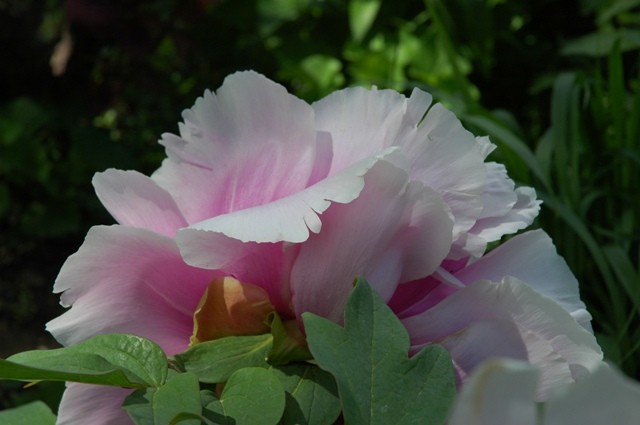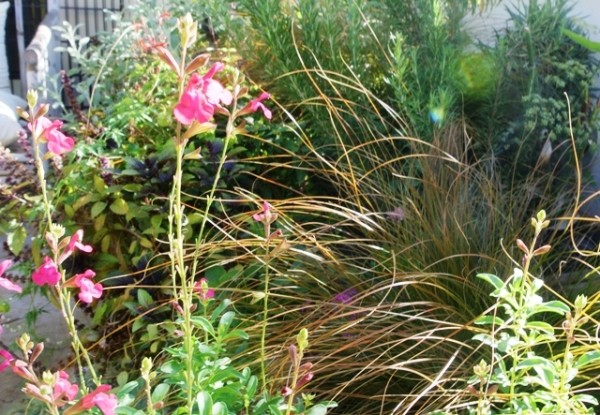Years ago when Prince Charles mentioned that he talked to his plants, people rolled their eyes. Only those of us who worked with or had a connection with them knew why talking to plants really can make a difference- for both you and your plants.

I’ve been doing it for years. I wrote about an emotional interlude I had with my plants in the New and Revised Edition of my book, Digging Deep: Unearthing Your Creative Roots Through Gardening.
“As I was preparing to graduate from seminary, I sold my house. I felt it was time to downsize and create a new garden. When I visited the last time, I felt strangely calm until I entered the garden. As soon as I walked through the back arbor, tears began forming. I said good-bye to the red velvet rose bush sprawling across the wall, which I had bought decade earlier for only a few dollars. Every few step I stopped, cradles some plants in my hands, and bid them adieu; telling them, like children, to take care of each other. Perhaps someone watching might think I’d gone crazy, but I knew otherwise. These beautiful living things were so deeply connected to me, and I to them, that parting was exquisitely painful.”
Michael Pollan, in an article written for The New Yorker, The Intelligent Plant, talks about the new field of plant neurobiology.
Pollan says that plants have all of the same sense as humans, but they have more. They have hearing and taste but also sense gravity, or feel something getting in the way of their roots before even coming into contact with it.
Scientists know that plants don’t have nerve cells like humans but they do produce neurotransmitters, like dopamine and serotonin- chemicals that we have in our brains that are used to send signals. There’s strong evidence to suggest that plants do have memories and can learn from experience.
As Pollan writes:
“Plants can do incredible things. They do seem to remember stresses and events. They do have the ability to respond to 15 to 20 environmental variables. The issue is, is it right to call it learning? Is that the right word? Is it right to call it intelligence? Is it right, even, to call what they are conscious. Some of these plant neurobiologists believe that plants are conscious — not self-conscious, but conscious in the sense they know where they are in space … and react appropriately to their position in space.” The New Yorker
So after hearing this information, why not give talking to plants a try??
5 Tips on Talking with Plants
1. Observe plants. It doesn’t matter if it’s one plant or dozens, whether it’s outdoors or indoors. If you’re a beginner, start with one plant. Take a few moments and stand or sit near it and begin to familiarize yourself with its shape, texture, color, leaves. Each day when you observe, notice if it has changed at all from the day before.
2. After a week of doing this, even if you feel that this entire concept is a bit ‘woo woo’, say a few words to the plant, either silently or out loud. It can be as simple as: ‘Hey, good morning, how are you today?’ or ‘You’re looking like you’re having a tough time…are you OK?’ or ‘Aren’t you a little beauty?” Do this at least once a day. When it comes to talking to your plants, my philosophy is: ‘more is better.’
3. Touch the plant. Have you ever cradled rose petals in the palm of your hands? Or shaken a poppy or dill flower to get seeds from them? There’s something sensual about touching plants. We gardeners do it when deadheading, cutting down plants, checking for bad insects, etc. Often, even while working at a clipped pace, I slow down, pause, and take a few minutes to touch the plants I’m working with in a gentle way. It’s not a big deal, really. It may feel funny at first: but like anything, when you practice, it becomes natural.
4. Think about how you’re helping the plant grow when you talk to it. There has been a lot of research done in this area: It’s stacking up to show the positive effects our talking and connecting with plants have on their growth and health.
5. Give thanks to the plant for nurturing you. As most pet owners will share with you, their pets are part of the family: it’s a loving relationship. You can have a loving relationship with your plant, if you’re open to the possibility. These living works of art bring beauty, optimism, and a sense of well-being into our lives.
So the next time you’re out in your garden –or any garden for that matter—bend over that mop head hydrangea in all it’s “Look at me, I’m gorgeous” glory and silently offer a ‘thank you’ for all that it brings into your life.
**If you liked this article, you may want to check out How Talking To A Tree Can Open You Up To Your Wise Self.


Hi Fran,
These words went straight to my heart, I could feel those emotions of parting with your plants, I have experienced this kind of adieu. I had read long ago that plants grow better in the company of soothing music, I too like to talk to my favorite plants but I do so silently, sometimes looking at them long enough to absorb the solace they provide, to assimilate the smiles that flowers pass on, to feel their tender touch and learn how to love unconditionally, how to give and million such message that they emit.
Thanks for sharing beautiful thoughts.
Balroop-
Excuse my delay in writing back to you. I was hit with a nasty bug. But when I got onto the site just now and read your beautiful words, my heart was singing with joy. I absolutely believe that plants grow better in the company of good music. When I go to work, I leave the classical music station on for my dogs- why shouldn’t plants be given the same attention? Oh yes, I agree with you about talking silently. I speak to the my plants with my heart and form the words in my mind. Although once in a while, i do hear myself inadvertently saying a phrase out loud. Thank you for your beautiful words Balroop. After a rough weekend, you have helped me start my week on a positive note. Warmly, Fran
Great reminder here Fran to spend a little more time with our plants. I haven’t really talked to my plants much in the past, but can see the value of it. I remember when I moved ten years ago, I brought a few special ones with me and then replaced my iceberg roses that I love, so I can relate to it being hard to say goodbye. Plants bring so much beauty to our world, talking to them seems like such a wonderful way to nurture them even more.
Cathy-
Thanks for your input. Plants do bring so much joy into our world….it’s important for us to slow down, pause, and notice them. Believe it or not, after I talk to my plants, I feel nurtured as well (go figure!) Fran
Plants have many ways to communicate! Did you know that if a sound of a caterpillar is played to a tree(which natural enemies are said caterpillars) the tree will start secreting a defensive scents (usually attracting wasps who then proceed taking care of the caterpillars by killing them.)? And that just because of the sound.
Gena- No, I didn’t know that. It is fascinating- although when you think of the majesty of nature, not surprising. Thanks for sharing that information. Fran
Hello Fran.
I do a weekly garden show for a community radio station here in Coffs Harbour NSW which is all voluntary. In researching about talking to plants I read your comments and I have to say it touched me deeply. Of us that love and respect our plants and gardens we can all relate to your story.
Thank you so much.
Hi Lex,
Sorry for the 2 year delay in responding. Thanks for your comment. Hopefully, with the entire world at a standstill, folks will spend more time in nature and come to the realization that we are all one… and that we, humans are part of nature. Once you have that belief system, talking to plants becomes quite natural. Stay safe and well. Fran